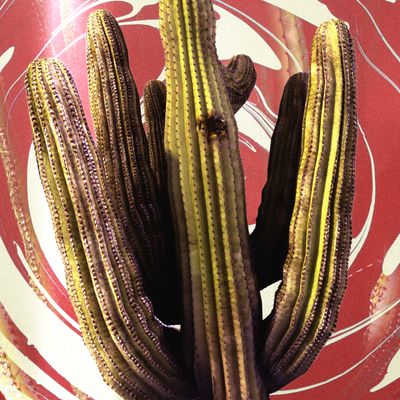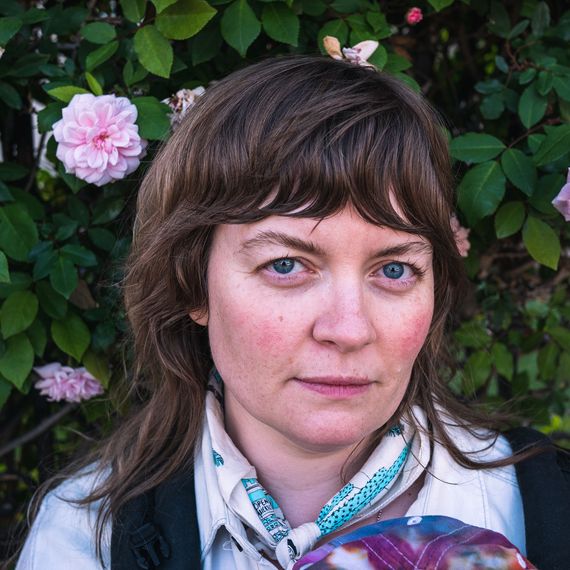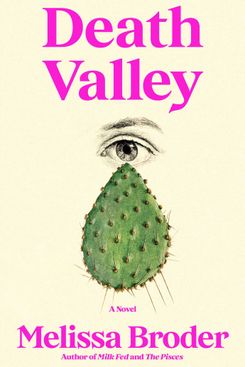
This piece contains spoilers for Melissa Broder’s Death Valley.
A giant cactus with Dr Pepper–dispensing nipples and a cool, wet slit. A mostly naked 41-year-old woman. Bitchy philosopher rabbits, talking rocks. Yes, I’m describing my hallucinations after accidentally taking an Ambien instead of an ibuprofen (why are both red and oblong?) — but also Melissa Broder’s wild third novel, Death Valley.
Like Broder’s previous novels, Death Valley is the darkly funny story of an “unhinged woman” trying to survive her own chaotic choices. Our narrator spends her days in the ICU, where her comatose father is five months into treatment after a car accident with no signs of imminent recovery. Her husband has a mysterious fatigue-inducing chronic illness that seems to be worsening. Her superstitious Jewish mother embroils her in Sisyphean tasks, like buying sweatpants for her father to wear when his condition improves and then returning them in case the presumptuousness of the purchase will summon the evil eye. It’s a lot for a woman who is terrified of death, and regularly feels like she’s “wearing a bra made of lead,” to handle. The novel opens with her deciding not to handle it — for now.
We encounter our narrator as she’s pulling up to a Best Western in Death Valley, California, under the pretense of working on “the desert section” of her novel. Really, she’s there “to escape a feeling … that I am still the kind of person who makes another person’s coma all about me.” Sardonic, self-implicating prose that cuts to the bone is Broder’s specialty, and Death Valley is probably the funniest book you’ll ever read about getting lost and almost dying.
Broder is a sensual stylist who writes the kind of sex scenes that sear in your mind. The Pisces featured anal with a devastatingly hot, possibly homicidal merman. In Milk Fed, a shtetl-core sapphic tryst with a closeted Orthodox Jewish woman. Death Valley presents her most audacious erotic encounter yet, between our narrator and a giant cactus that she meets on a hike. The Saguaro is wide as an elevator shaft and so tall our narrator would have to scale a wall to see it in its entirety. She feels “strangely drawn” to a vagina-looking wound along its side:
one of my fingers slips inside the slit … It’s slimy in there, cool and wet, refreshing in the parching heat … Gently, I glide my finger up and down the length of the long injury, feeling the cactus give. A second finger fits in perfectly. Then a third. Soon, I’m up to my wrist in moist flesh … I make a little noise like, “Unnghhh.” I go deeper in.
I know little of the girth and internal lubrication of giant cacti, but fisting one feels like a conceivable, however unlikely, possibility. Yet when the narrator moves her arm forcefully, the slit widens. She pushes her head, and then her entire body, inside. Suddenly, we’re in a moist, hollow chamber where her father as a small child sits, playing in the sand. He appears as she remembers him from an old black-and-white photograph. She watches him play for a while before exiting the cactus the same way she entered. Back at the Best Western, the front-desk staff deny having ever seen a giant cactus on that trail. Furthermore, Saguaros don’t grow in Death Valley.
Were these daydreams? Hallucinations? Scenes from the book the narrator is writing? Or did this otherwise realist novel slip into magical realism? The narrator acknowledges the strangeness of her mystical cactus encounter yet seems to regard it as real. Ultimately, Death Valley doesn’t provide an explanation. If Emma Cline’s The Guest was this summer’s most intoxicatingly elusive read, I nominate Death Valley as this fall’s pick.
My personal cactus theory centers on a Søren Kierkegaard quote from the novel’s first page: “Life is not a problem to be solved, but a reality to be experienced.” The narrator describes that quote as “a life raft, as though I were a small version of me adrift in a bowl of milk and the quote was the lone Cheerio I had to grab onto.” She’s endeavoring to be more open to the unknowability of the universe, a tall order for someone who can never shuck the sense that she is doomed for long.
It is that hunt for a solution — to the question of whether the cactus is real — that leads to the narrator nearly dying. When she checks out of the Best Western and decides to walk the trail one last time, she’s unnerved to find that the giant cactus isn’t where she left it. She wanders in search of it and gets lost. For days, she rations her meager provisions as her injuries — a broken ankle, a wrist contusion, torrential diarrhea after flambéing a cactus — become increasingly dire. Her ticket home is the realization that she actually wants to return, that she may never feel at home within herself, and that the people she loves are the only home she knows. The epiphany summons a large, fatherly bird who drops her off by the giant cactus. Back inside the Saguaro’s gash she goes. There, she suckles a nipple that lets down her father’s favorite drink, Dr Pepper, and gives her the strength to go on. A version of her husband is there too — 20 years old, hot as Death Valley itself, with a monstrous boner. In her words, “Hot wet health in river paradise.” Tempted as she is to stay in the magic cactus with her “husband the healthy,” she can’t stomach the thought of abandoning her “husband the sick.” She leaves the cactus and is promptly rescued. Prioritizing her husband’s wellbeing — doing the opposite of “making someone else’s coma all about me” — saves her life.
Did these events “really” happen? I lean toward Ann Patchett’s response when asked how much of her family life she borrowed for her novel Commonwealth: “None of it happened, and all of it is true.” There’s evidence in the text that Death Valley’s narrator anthropomorphizes her surroundings to cope with her anxiety. The talking rocks that guide her hikes, her imagined conversation with the rabbits she steals from, a sanguine rose sent by her U.K. publisher when the narrator is recovering in the hospital. “If I could define my terror — of life and dying and loving and all of it … I would say: It keeps going. It keeps going and also it will end,” she tells the wilting rose in the book’s penultimate chapter. “And also …” the rose prompts. Something clicks for the narrator then. Yes, life and love will end. “And also,” she tells the rose, “It keeps going.”
Death Valley’s mysticism works because — not in spite of — its ambiguity. The narrator’s encounter with the cactus transforms her erotically by awakening her desire for her husband without negating her queerness and desire for others. It transforms her relationship with death by forcing her to confront the inevitability of her father dying and her ability to survive it. And, most significantly, it transforms her relationship with herself. She can’t shed the doom that lives rent-free inside her, but she makes strides toward not letting it have the last word. Whether a giant Saguaro with a magic pussy is truly out there vibing in the desert, revealing itself only to those who need it most, is arguably beside the point.
At least, that’s my take. It’s not the only possibility, so I reached out to a handful of Broder’s contemporaries to see how they interpreted Death Valley’s mystical cactus encounters.
Emma Specter, Vogue staff writer and author of the forthcoming memoir, More Please:
As a person of “taking one too many edibles in Death Valley and hallucinating the presence of an all-seeing, not-entirely-pleased-with-me-God” experience (just once, but that kind of thing really stays with you), I relate to Broder’s protagonist’s quest to identify the giant cactus she comes across in the desert. Is the cactus real? I’m not sure, but I do know that sometimes it’s not enough to just be in the presence of something mythical-seeming; you have to ID it, slap a name and a label on it, and prove to the world that you’ve seen it, or what was the point? (Insert predictable scoff about toxic Instagram culture here.)
Isle McElroy, author of People Collide and The Atmospherians:
Whether the cactus in Broder’s novel is real doesn’t interest me. What interests me is that the narrator sees the cactus, has an experience with it, and no one else in this world can affirm that experience. Metaphorically, the cactus could be many things: it’s queerness, it’s her father, it’s the void that summons us all. Most importantly, though, it is up for debate. It creates a rift in this world between the narrator’s experience and that of everyone else, and in this rift is where the profound tends to reside. The cactus is a portal to something that cannot be conveyed, something the narrator — preemptively grieving her father and her marriage — has to grapple with on her own. The cactus is The Inexplicable. It is surreal and nonexistent and the most real part of the book: It is what we turn to in the midst of grief and confusion, an object through which we attempt to build meaning out of a widening puddle of meaninglessness. It’s probably prickly too.
Zoe Jackson, journalist and one of BookTok’s most popular literary-fiction influencers (@zoes_reads):
As usual with Broder, I’m caught between wanting to live in her brain and wanting to run far, far away from it. Our girlie is going through it — and I think that the nearly lethal combination of dehydration in Death Valley and the anticipatory grief she was experiencing led to some of our unnamed narrators’ wild hallucinations (delusions?). Ultimately, I don’t think what she experienced in the cactus “actually happened.” But, in the face of the unimaginable grief of losing a parent, if it made her feel better and helped her survive — both the desert and the loss — that doesn’t make it any less “real.”
Lisa Locascio Nighthawk, author of Open Me:
The Giant Cactus scenes are a departure from the rational, cynical, hard-bitten, desperately trying-to-survive vibe that characterizes the rest of the novel. They are the moments when the protagonist allows herself to feel everything she has been suppressing. Like all suppressed emotion, when her grief, terror, and love finally emerge, they overwhelm her. Death Valley has a wry, genuine sense of humor — the scene where she’s FaceTiming her father who has recently emerged from a coma and “Gasolina” starts playing loudly makes me laugh every time I think about it — but the humor is armor, heavy and protective, and it costs a lot to carry. In her giant-cactus reveries, the protagonist can finally lower her defenses and experience the world of feeling she has been fleeing. Whether she’s hallucinating, transported to another realm, in communion with a great spirit, or something different entirely is beside the point. What matters in these scenes — and enables them to anchor the book — are the soft, vulnerable, yet unafraid details that deliver the book’s message about the frailty and incandescence of our short all-too-human lives. The “violet mouth” of “my husband the healthy,” the cigarette shared with the teenage father; these are images beyond language that open spaces beyond story.
Ilana Masad, critic and author of All My Mother’s Lovers:
Real, not real, hallucinated, invented whole cloth — those ideas don’t make much sense to me in a surreal novel of grief and fear and lostness. The scenes are as real as the narrator, novel, and reader need them to be. The narrator is least comfortable in the “realm of feeling.” She’s cerebral, using words and wry humor and self-deprecating brutal honesty to protect herself from “just being,” an idea that is nice but also very L.A. in that it’s so tied to wellness culture and so holier than thou. The cactus seems to be a place where she can feel cerebrally, but still feel. It’s a womblike place — moist to enter, safe and warm once she’s in it, but also weird as fuck which, like, wombs are — and there she sees earlier incarnations of her father and husband, and in one moment becomes a baby herself. Who is to say that creating narrative isn’t, too, a way of inhabiting a feeling realm?
Fortesa Latifi, Teen Vogue features writer:
Should I start by flexing that I’m from Arizona, so cactuses have been really formative to my life? Well, there it is. Does the big cactus even exist? Is the narrator hallucinating? I hate to be all desert mystic about this but, again, native Arizonan. I think the cactus exists, at least to the narrator. Does that mean if you or I went looking for it, we would also be able to find it? Maybe it’s a cactus that only presents itself to people who need to talk to the child versions of their dads (which, honestly, is all of us). The desert is a really strange place, and it doesn’t live by the same rulers as the rest of the universe. The cactus exists — or at least it exists to the narrator. Maybe you have to be a sad writer to find it. I’ll let you know.











